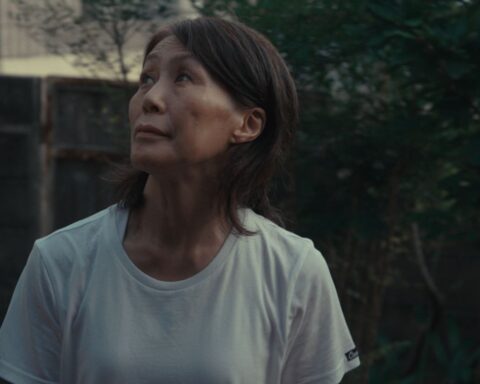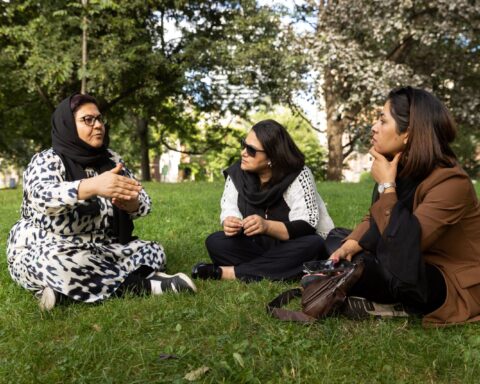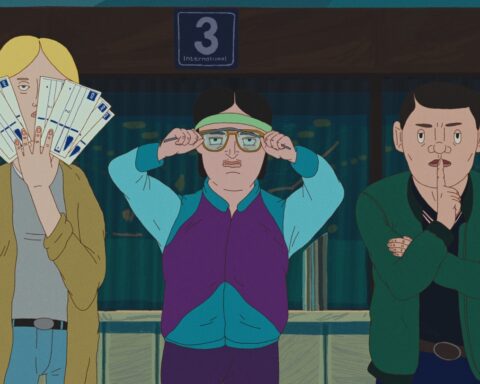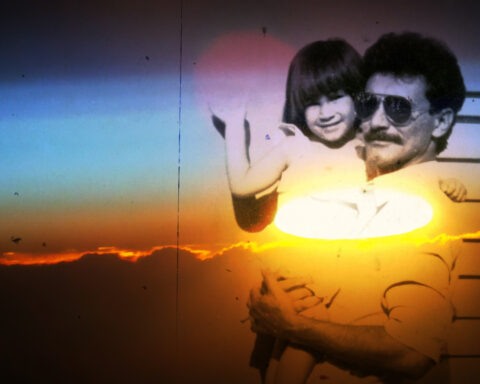THE END IS NIGH but you probably knew that already. In the nine years since Al Gore and Davis Guggenheim’s An Inconvenient Truth sounded alarms about climate change and widened the potential audience for activist-minded documentaries, viewers have withstood a daunting torrent of urgent docs about the innumerable phenomena that foretell our species’ imminent doom. Whether the subject is collapsing bee colonies, shrinking icebergs or dying oceans, most of these films share a familiar formula: 90 minutes of very, very bad news followed by a concluding note of hopefulness as we learn how we too can effect the necessary change to avoid a fate that’s pretty much certain anyhow. (And no, signing yet another Facebook petition will not do the trick.)
By now, viewers know full well that they should be worried about the state of the Earth. “They’re told it every day,” says Sasha Snow, a London-based filmmaker and cinematographer. Given that fact, Snow believes that filmmakers and writers have an important new responsibility. “That’s to keep people engaged with it and find fresh ways of helping them relate to it,” he says, “especially emotionally.”
Snow’s film Hadwin’s Judgement is one of several environmentally themed new titles that make their world premieres at Hot Docs. Though these works’ subjects are as varied as their creative strategies, the best of them deviate from the eco-doc template in ways that are startling, moving and possibly far more effective than the means of more didactic counterparts.
In the case of Snow’s film, those strategies include using dramatic reenactments and a vivid exploration of natural settings to recount the tragic story of Grant Hadwin, the B.C. forest engineer who felt so wracked by the devastation of the land he loved that he destroyed one of the world’s most sacred trees as a protest against the logging industry in 1997.
Another new film that grounds its themes in the experiences of a compelling—though this time still living—protagonist, Fiona Rayher and Damien Gillis’ Fractured Land examines the internal conflicts and public challenges of Caleb Behn. With his signature uniform of Mohawk hairstyle and crisp suit and tie, the First Nations activist is presented as an eminently modern kind of indigenous warrior as he tries to halt the oil and gas industry’s new quest for shale-gas riches in the remaining wilds of Western Canada.
Shifting the emphasis from the dramatic trajectories of individuals to the past, present and future of a community, Charles Wilkinson’s Haida Gwaii: On the Edge of the World invites viewers into one of Canada’s most beautiful yet fragile regions, as well as into the lives of the stubbornly self-sufficient and often eccentric people who populate it. More global in scope but just as rich in its portrayal of wildlife (including the human variety), Su Rynard’s The Messenger looks at the myriad threats to the world’s population of songbirds and compels audiences to consider what life without their music will be like.
As wildly different as the films may be, each is able to pursue its timely themes—and offer some even timelier warnings—in a manner that’s engaging, cinematic yet refreshingly unpolemical. That’s true even with the potentially incendiary story of Hadwin’s Judgement. After all, Snow says that his subject’s destruction of the Golden Spruce, a 1,000-year-old tree that had been revered by the Haida, continues to be a “raw wound” for many in the community and throughout B.C., even 18 years after the events depicted in the film.
Snow himself spent nearly a decade trying to make Hadwin’s Judgement. He was introduced to the story in 2006 when Canadian journalist and author John Vaillant contacted him after seeing Snow’s film Conflict Tiger at a festival in Banff and told him he wanted to write a book about it. The journalist also sent him a copy of The Golden Spruce, his book about Hadwin’s saga. Like many readers, Snow was enthralled by Vaillant’s Governor General’s Award winner, and the two men’s burgeoning mutual appreciation society would eventually yield Vaillant’s 2010 book, The Tiger, and now Snow’s film.
Though the NFB was hugely supportive of the project from the beginning, the search for international producing partners was a long one. Even when the U.K.’s Passion Planet Pictures came on board, Snow could understand his new producers’ reservations. “They said, ‘You’ve got a dead man and a dead tree in a forest that doesn’t really move. How are you going to make that visceral? How are you going to make people feel it?’”
Yet Hadwin’s Judgement achieves this by a variety of means, the strongest of which is its ability to situate viewers within both the environments that moved Hadwin so profoundly and the mental space that was rather more troubled. (The film takes its title from the manifesto that appeared around the time of his disappearance at sea while travelling to a court appearance.) Concerned that the film could become another kind of manifesto, Snow pruned away any moments that felt like “lecturing the audience.” But as he says, “Of all the ideas I wanted to get in there, it was that battle between the anthropocentric view of the world and the concentric view. There was a certain perversity in the fact that Grant came from the heart of the anthropocentric machine and yet, independently of any knowledge of indigenous culture, he shared their beliefs. Then he completely unwittingly wandered into their arena and attacked the being that most clearly represented his utopia.”
One of the story’s biggest ironies is that Hadwin’s act had some of the desired effect by galvanizing efforts to protect B.C.’s old-growth forests. Yet the impact of resource exploitation on First Nations communities and the environment at large is a subject of the utmost urgency in Fractured Land. Co-director Fiona Rayher admits she didn’t know just how swiftly and dramatically the northern landscape is being transformed due to shale-gas extraction by hydraulic fracturing operations (fracking, for short) until her interest was spurred by an encounter with Gasland director Josh Fox at TEDxVancouver in 2010. Teaming with her friend Damien Gillis on what was initially planned as a short film on the topic, she first met Caleb Behn during a research trip to northern B.C. As the son of a chief who’s adamantly opposed to the oil and gas industry and a lawyer who works within it to protect Aboriginal rights, Behn knows all too well the divisions within his community and the precarious balance he must strike as an activist and an officer of the court trying to “speak truth to power.” The personal has rarely seemed more political.
After meeting Behn, Rayher quickly recognized that his experience could be a framework for a wide range of topics. “It’s pretty hard to argue with someone’s personal story,” says Rayher. “Caleb not only has to navigate these fractures inside his community and the world around him, but [also] the ones inside himself. It’s also interesting to see how the fractures in the land mirror the fractures in the person. To see all this through his eyes became a much more compelling way of talking about the issues.”
Behn’s travels and increasing prominence as a speaker also allowed the filmmakers to expand the front line, with Behn as a roving connection point between often disparate actions by First Nations groups. “I hope this film will serve as a unifying document or record of what is going on in Canada right now, particularly from the Aboriginal perspective,” says Gillis. “There are so many different pockets of resistance and conflict, but Caleb’s story weaves through all of these places, from the Mi’kmaq in Elsipogtog to protests of pipeline projects throughout B.C.”
Yet Rayher hopes Fractured Land serves more as a personal portrait than a more conventional piece of agit-prop. “We didn’t want to put this film in an activist box and give people a call to action at the end,” she says. “It’s more about saying, ‘This is the story, this is what happened: it’s raw, it’s real.’ At our screenings so far, some people feel heartbroken, some feel empowered, some feel like they’ve learned a lot. Leaving it open-ended is important for this kind of story. The film becomes more of a tool to generate dialogue.”
The same could be said of Peace Out and Oil Sands Karaoke, the first two parts in what filmmaker Charles Wilkinson describes as a trilogy of films about “the gold rush sweeping the top of our planet.” But whereas its predecessors presented an often troubling view on the impact of this gold rush on Canada’s northwest, Haida Gwaii: On the Edge of the World is at least tentatively hopeful in its depiction of the community on a remote archipelago on B.C.’s northern coast and its efforts to create a more sustainable future.
“When people talk about Haida Gwaii, they’ll often talk in superlatives, about how it’s this really pristine place and everything’s really perfect,” says Wilkinson. “Or else they’ll talk about this horrible history, about the logging extraction and mining, the small pox and the residential schools. The reality of the place is quite different. It’s not perfect at all and people struggle to make a living there, as I hope we showed in the film. Yet the thing that made it so attractive is that discussions are being had and people are concerned about sustainability. That’s because they have to be—they can’t turn to anywhere else.”
So as much as Wilkinson’s film inevitably revels in the supernatural-B.C. beauty of the place, it’s also remarkably astute about the various factors—economic, environmental, social and political—that make Haida Gwaii a potential model for communities that may soon be facing even graver challenges (in other words, all communities). “It’s not paradise by any means. There are tons of problems there,” says Wilkinson. “But I see the beginnings of a solution there.” First Nations self-determination is a big part of that, and Wilkinson hopes that viewers heed the example set by the Haida’s gruelling but ultimately successful efforts to “bring corporations and governments to heel.”
“Here we’re the slaves and they’re the masters,” says Wilkinson, who made the film with his producer and partner Tina Schliessler. “But on Haida Gwaii, that’s not the case.”
A key theme in Haida Gwaii: On the Edge of the World, the interdependence of people and the natural world, is even more strongly conveyed in The Messenger. That was very much the hope for Toronto-based media artist and filmmaker Su Rynard, who was equally interested in the ways of humankind as she was in the worrisome conditions for the feathered creatures who were ostensibly her new movie’s subject.
“I didn’t want to make a ‘nature film’ or a film about birds,” says Rynard, whose project spanned five years and three continents. “I really wanted to ground the film in human activity so that we see this world of birds, not as something that exists outside of ours, but as one world we all inhabit.”
Despite the fears it raises about a world without birdsong, The Messenger hums with the kind of restless energy that’s all too rare for an eco-doc. That’s a testament to Rynard’s success at finding so many dynamic human subjects, all striving to save songbirds from threats that range from the effects of climate change to pesticides to hungry felines. It also benefits from an unconventional structure that more closely resembles the migratory patterns of songbirds (or even the music they make) than the more explicit through-lines of so many other message-minded docs.
“We did have a rough cut early on that was like that,” Rynard says. “But as you shape the material, the material shapes you too, right? So early on in the editing, we thought, ‘No, that’s definitely not right—we just have to weave all these things in.’ We wanted to make it watchable in that way, so that you’re not making people feel guilty. Obviously it’s an emotional journey but you don’t want to just make someone feel bad, sad or overwhelmed. It’s definitely a challenge to find that tone. It’s even a hard tone to articulate because it’s so subtle.”
Nevertheless, that tone is another means by which a filmmaker can create a world for audiences to enter rather than batter them with another barrage of very bad news. After all, if all these matters of doomsaying and world-fixing could be put in a pamphlet, then they might as well be. As Rynard jokes, “It would be a lot easier!”
Hot Docs 2015 Screenings
Hadwin’s Judgement
Mon, Apr 27 8:30 PM – TIFF Bell Lightbox 3
Wed, Apr 29 4:00 PM – Scotiabank Theatre 4
Thu, Apr 30 9:00 PM – ROM Theatre
Fractured Land
Tue, Apr 28 9:00 PM – TIFF Bell Lightbox 2
Thu, Apr 30 2:30 PM – Scotiabank Theatre 8
Sat, May 2 4:00 PM – Scotiabank Theatre 8
The Messenger
Tue, Apr 28 9:00 PM – Scotiabank Theatre 4
Fri, May 1 1:30 PM – Scotiabank Theatre 7
Sun, May 3 6:30 PM – Innis Town Hall
Haida Gwaii: On the Edge of the World
Tue, Apr 28 7:15 PM – TIFF Bell Lightbox 3
Wed, Apr 29 4:30 PM – ROM Theatre
Sat, May 2 8:15 PM – TIFF Bell Lightbox 3
Sun, May 3 7:00 PM – Hart House Theatre








